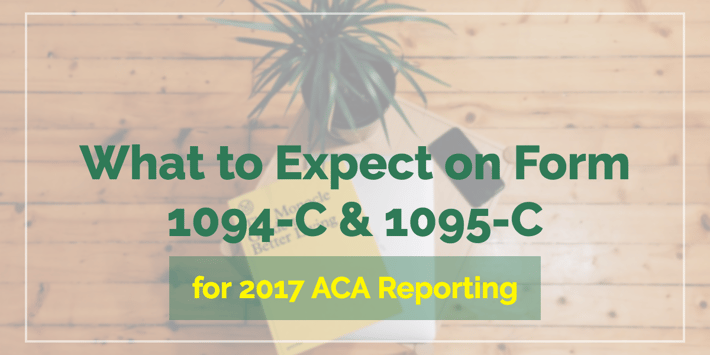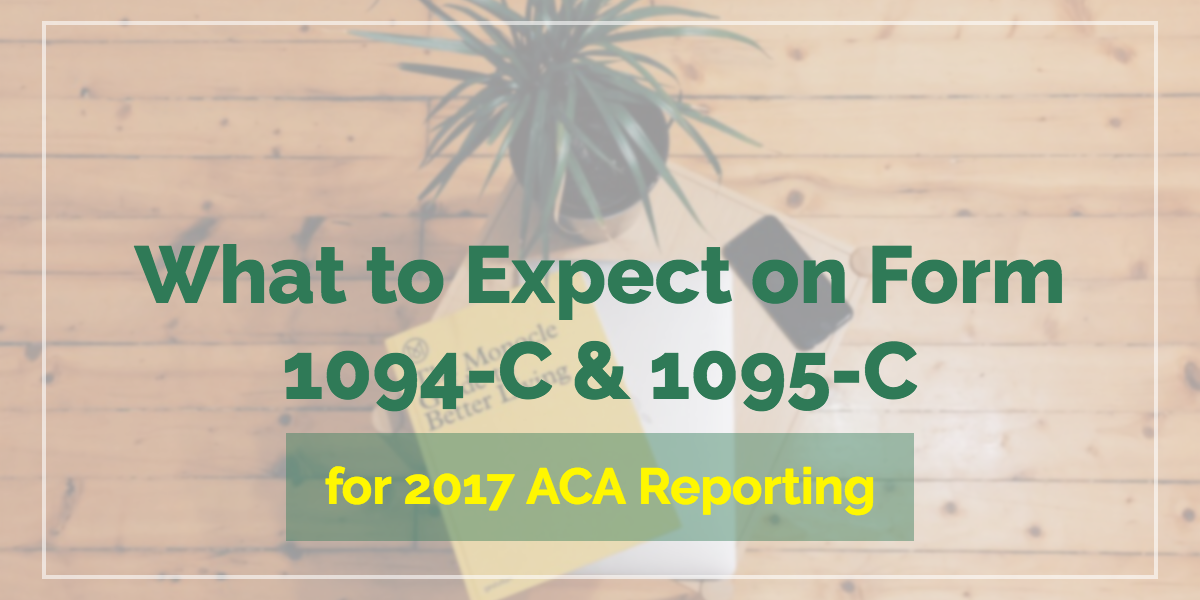
Though it seems we’ve only just wrapped up ACA reporting in 2016, we’re already looking ahead to ACA reporting requirements for 2017.
According to the Affordable Care Act, if you’re an Applicable Large Employer (ALE) with 50+ full-time and full-time equivalent employees in the previous year, you must file one or more Forms 1094-C and a Form 1095-C for each employee who was a full-time employee for any month of the calendar year.
The IRS recently released draft 1094 and 1095 instructions and forms for ACA reporting in 2017. Typically, the IRS will try to wait to release any drafts until they feel there will likely be no other changes to the form, although more changes are always possible.
For the most part, HR managers will recognize these forms from last year. But there are a few important changes to Form 1094-C and Form 1095-C to note. You may download copies of the draft ACA reporting form and instructions:
Draft 1094-C instructions and form for 2017
Draft 1095-C instructions and form for 2017
*These are not the final forms and cannot be used for filing with the IRS.
New Changes to Form 1094-C and 1095-C for ACA Reporting in 2017
Verbiage Change to the Form Instructions
(Both 1094-C and 1095-C) The term ‘Employer’ has been replaced with ‘ALE Member’ in many cases throughout the form instructions to remind employers that each separate ALE member must file its own forms.
If a small business employer is a member of a controlled or affiliated service group that has 50 or more full-time equivalent employees all together, that employer will also be responsible for furnishing and filing C-series forms 1094 and 1095. For example, a medical clinic is owned by several physicians in equal share. A regional staffing company employs the support staff at the clinic, and the clinic is a shareholder in the staffing company. This would be an affiliated service group.
New indicator codes for Line 14 of Form 1095-C
(Form 1095-C) The new codes on Form 1095-C reflect conditional offers of coverage made to an employee’s spouse. For 2015 reporting, all offers of coverage to an employee’s spouse had to be reported in the same way, whether the offer was conditional or not.
1J. Minimum essential coverage providing minimum value offered to you; minimum essential coverage conditionally offered to your spouse; and minimum essential coverage NOT offered to your dependent (s).
1K. Minimum essential coverage providing minimum value offered to you; minimum essential coverage conditionally offered to your spouse; and minimum essential coverage offered to your dependent(s)
What makes an offer of coverage conditional? An offer is considered conditional if it is subject to one or more reasonable conditions. For example, if an employee’s spouse must certify ineligibility for health coverage through his or her own employer, the offer of coverage is conditional.
New Coding Instructions for COBRA Coverage
(Both 1094-C and 1095-C) There has been much confusion over offers of coverage for terminated and retired employees. Hopefully, the revised instructions will help clear up some things in the matter. To code offers of COBRA coverage use 1H (Line 14) and 2A (Line 16) whether or not any elections for COBRA coverage were made. This coding also applies for non-COBRA post-employment coverage as in the case of a retiring employee. If the retired employee was a full-time employee for at least one month of the year, employers should use this coding sequence.
Additional Insights for Calculating FTEs
(Form 1094-C) The IRS clarifies in the form instructions that calculation of full-time employee status is solely determined by the rules under Code 4980H. Any other regulations, including those established by an employer, do not apply in determining full-time employee status for the ACA.
We still await some clarification, however, on the measurement periods. Currently, the draft instructions mention the monthly measurement period to determine FTE status and not the look-back period. This could be a clarification added when the IRS releases the final form instructions.
Changes to Transitional Relief That is No Longer Applicable
(Both 1094-C and 1095-C) The IRS removed the Qualifying Offer Transitional Relief box on Line 22, labeling option B as ‘Reserved’ on 1094-C and Line 14 code 1I on 1095-C. This relief was applicable to those reporting on the 2015 calendar year for non-calendar year plans that began in 2014. Section 4980H Transition Relief is still relevant for non-calendar year plans that began in 2015 and extend into 2016.
No More ‘Good Faith’ Compliance Standard
(Both 1094-C and 1095-C) Under Code sections 6055 and 6056, all ALEs must use forms 1094-C and 1095-C to report required information about whether or not the ALE member offered affordable minimum essential health coverage (MEC) and enrollment in minimum essential health coverage for eligible employees.
In the past, the IRS has extended some grace to those who have demonstrated a ‘good faith effort’ to furnish and file forms 1094-C and 1095-C correctly. In 2017, employers should expect to face penalties for forms completed incorrectly or filed late. Regardless of an employer’s effort, the IRS will waive reporting penalties only upon reasonable cause and not for ‘good faith’ efforts.
It’s important for employers, HR, and payroll to be educated on these ACA reporting forms and work together to gather the right information and correctly complete them. If not, expect some major penalties from the IRS. Don't put off ACA compliance—get more resources on ACA reporting today.

